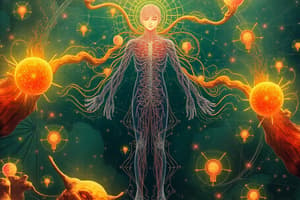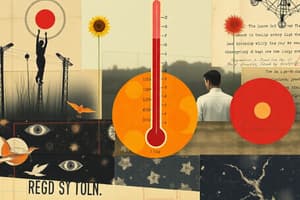Podcast
Questions and Answers
Which type of bond involves the transference of electrons from one atom to another?
Which type of bond involves the transference of electrons from one atom to another?
- Polar Covalent Bonds
- Ionic Bonds (correct)
- Non-Polar Covalent Bonds
- Hydrogen Bonds
Which process involves the breakdown of larger substances into smaller ones?
Which process involves the breakdown of larger substances into smaller ones?
- Buffer Chemical Systems
- Anabolic Reactions
- Hydrolysis Reactions
- Catabolic Reactions (correct)
Which type of sugar is not a simple sugar?
Which type of sugar is not a simple sugar?
- Glucose
- Deoxyribose
- Sucrose (correct)
- Fructose
Which level of protein structure involves the folding of polypeptide segments into alpha helices and beta pleated sheets?
Which level of protein structure involves the folding of polypeptide segments into alpha helices and beta pleated sheets?
Which type of bond is formed by a dehydration synthesis reaction?
Which type of bond is formed by a dehydration synthesis reaction?
Which part of a nucleotide is involved in the formation of hydrogen bonds in DNA?
Which part of a nucleotide is involved in the formation of hydrogen bonds in DNA?
What type of feedback loop results in a change in the opposite direction of the initial variable change?
What type of feedback loop results in a change in the opposite direction of the initial variable change?
Which type of transport moves substances against the concentration gradient, requiring energy expenditure?
Which type of transport moves substances against the concentration gradient, requiring energy expenditure?
How are gradients formed?
How are gradients formed?
What is the primary factor contributing to an element's atomic mass?
What is the primary factor contributing to an element's atomic mass?
How many neutrons does an atom of a given element have when it is an isotope?
How many neutrons does an atom of a given element have when it is an isotope?
What type of chemical bond is formed between two or more nonmetals?
What type of chemical bond is formed between two or more nonmetals?
Flashcards are hidden until you start studying




